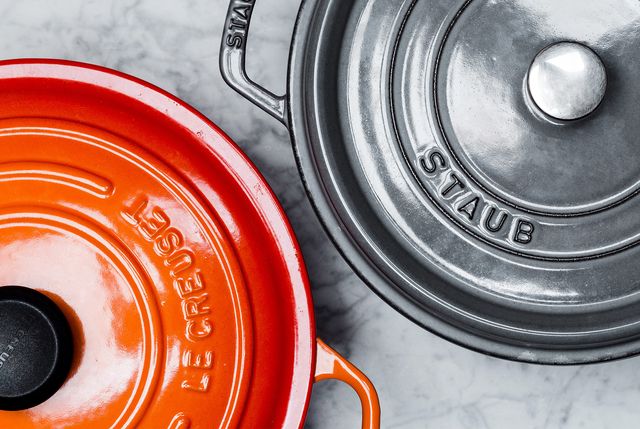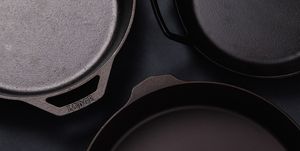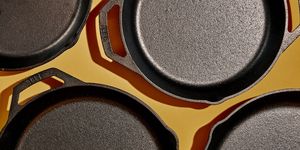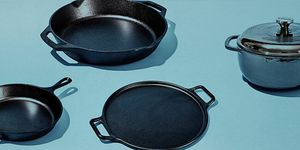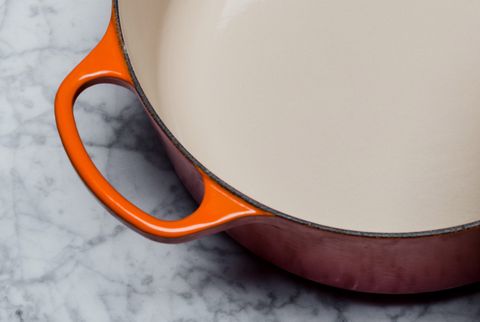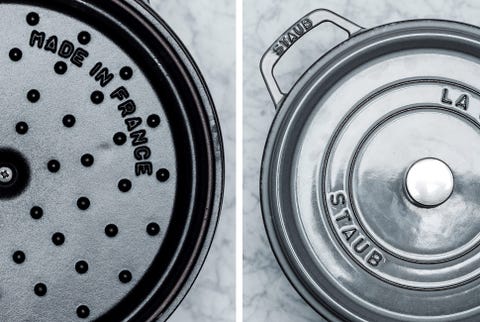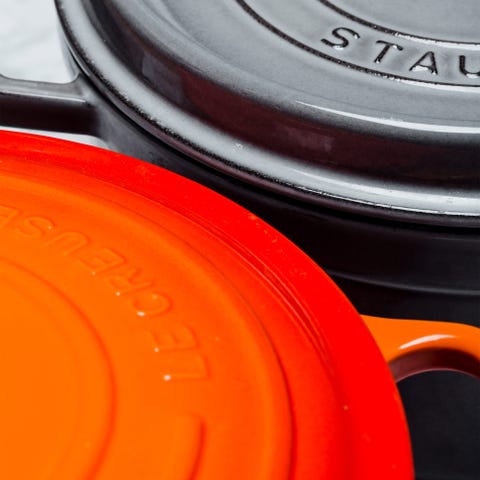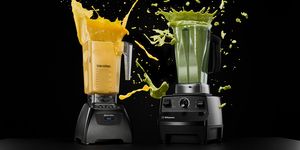The role of the enameled Dutch oven is to serve as a vessel when preparing anything that takes a while to cook. Their weight keeps temperatures even during hours of cooking; their tight-fitting lids keep moisture in; and because they’re in fact cast iron, they’re capable of reaching heat levels needed to acquire crusty goodness (though enameled cast iron won’t reach the peaks that bare cast iron will).
Any discussion pertaining to enameled cast iron begins and ends with two brands: Le Creuset and Staub. Both are French, and share the crown by delivering on similar promises: slow-but-even heating, extra durable enameled interior and exterior, fitted lids, unmatched braising abilities and, finally, lifetime warranties. You’ll frequently find sales on both brands, but, if you’re going to drop the kind of coin required to pick one up, you should know which to buy and for what reasons.
To draw my own conclusions, I tested a 5.5-quart model from each brand and made the most stereotypical Dutch oven dish there is — the classic beef bourguignon — as well as a few other recipes. This is the short of it.
Staub vs Le Creuset Dutch Ovens: What We Think
If we’re just measuring the ability to cook, the Staub is the superior vessel. Its lid's self-basting drip function, as well as its much tighter fit, are not just buzzy features, they affect your finished dishes. It browns to the same capacity as the Le Creuset and its lid handle isn’t temperature-limited. But convenience-wise? By way of much simpler care and cleaning, coupled with an interior enamel that’s passively helpful, the Le Creuset is easier to take care of on all accounts.
If you’re still on the fence, use price to guide you — the Staub is slightly less expensive. Then again, Le Creuset offers more striking colors. The choice is yours.
To learn more about our testing methodology and how we evaluate products, head here.
Staub vs Le Creuset: What are the biggest differences?
There are more subtle differences between Staub and Le Creuset Dutch ovens, certainly, but these are the features that make the most difference while cooking.
Interior Color
The inside of the Le Creuset Dutch oven is creamy white, while the interior of the Staub Dutch oven (which they call a Cocotte) is dark grey. The aesthetic difference is an important one, as seeing the level of browning on the food you're cooking is essential to timing. The lighter color of the Le Creuset makes this simpler, and also makes cleaning marginally easier.
Weight
No matter what size vessel you're shopping for, Le Creusets are lighter than Staubs. The difference can be felt, but isn't so great that either suffers tremendously from it. The Staub's heaviness means it holds temperature more evenly and for longer, while the Le Creuset's lightness makes lifting a full pot of beef stew from the oven a little less daunting.
Lid Fit
The Staub's lid fits more tightly than the Le Creuset's. This means less liquid steams or boils off during longer cooks in a Staub than in a Le Creuset. Whether you want moisture to escape a lidded pot or not is dependent on the dish you're cooking; many soups and stews aren't meant to lose much moisture once assembled, while braising something like short ribs you plan to lose water to deepen flavor.
Dutch Oven Test 1: Browning
Most reviews online claim the Staub browns more effectively, but this was not my experience. I heated both ovens up for 10 minutes on high heat and developed crusts indistinguishable from one another, whether I was browning protein or veggies. In comparison to Staub’s matte black interior enamel, Le Creuset features a creamy white interior that makes it much simpler to track the browning progress. This might seem like a small advantage, but, with the Staub, it can be mildly frustrating to pull out a phone flashlight to check progress.
Dutch Oven Test 2: Moisture Retention
The lid of a Dutch oven needs to be hefty and fit well to the body. Le Creuset’s lid is fairly standard in this regard, apart from the 500-degree safe phenolic knob handle. It fits well, but steam still visibly slips through and out of the pot. The Staub is on another level in this regard. Tiny nubs on the inside of Staub’s lid collect condensation and slowly drip back onto the food below (Wagner Ware’s Drip-Drop Dutch Oven of old has a similar lid design), and the lid fits onto the body well enough that hardly any liquid escapes.
To test, I boiled five cups of water in each at high temperatures for about 10 minutes. The Le Creuset boiled out a little over a cup of water, while the Staub lost less than half a cup. With many dishes, you’ll want to cook off excess water in order to concentrate flavor, so this isn’t necessarily a full-fledged plus. That won’t stop you from placing the lid off-center to let some steam out, though.
Dutch Oven Test 3: Care and Storage
Due to its white interior, the Le Creuset makes it easier to see what you’re doing (in this case cleaning off burnt bits and brown marks), and I didn’t have any issues with staining or discoloration. Folks who do have this problem have likely left the food in the pot overnight or more and let it sit too long. It’s also dishwasher-safe, which is hugely convenient if you’re just not in the mood to scrub.
The Staub, whose black interior hides leftover food bits, should not be dish-washed, as its interior enamel is porous and can be degraded by the chemicals in dishwashing detergent (Note: Staub says you can run it through the dishwasher, but you should avoid it if able).
As far as storage and maneuverability go, neither are particularly comfortable to pick up or put down. They’re big and bulky and you probably don’t need more than one per kitchen. That said, the Le Creuset is slightly lighter.
I’d advise against giving either the Matryoshka doll treatment by stacking all manner of other cookware inside — the enamel coating is very strong, but coming into contact with another heavy metal object is asking for a chip. And these pots are already heavy enough without the rest of your cookware nesting in them.






